An Encounter with a Grand Canyon Black Tarantula (Aphenopelma marxi) in Southwestern Colorado
It's Fall - time for our male Tarantulas to roam!
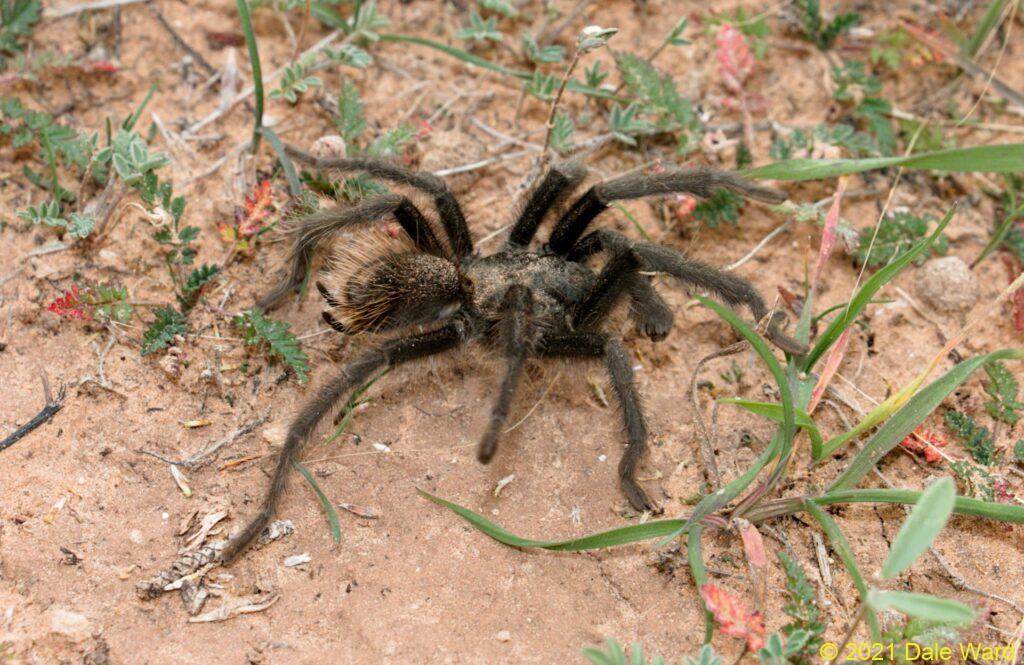 Male Grand Canyon Black Tarantula roaming on the desert floor
Male Grand Canyon Black Tarantula roaming on the desert floor
A couple of days ago I was out in the high deserts of Southwestern Colorado, revisiting one of my Spadefoot Toad pools. As I expected the water was all gone from the pool, nothing left but cracked mud and dust.
As I was hiking back to the truck, I came across a small black Tarantula that was striding across the desert floor.
This was a male Tarantula. Mature males come out of their holes and search for females in the Fall of the year.
This spider’s size was pretty typical - these Tarantulas are pretty small, as Tarantulas go.
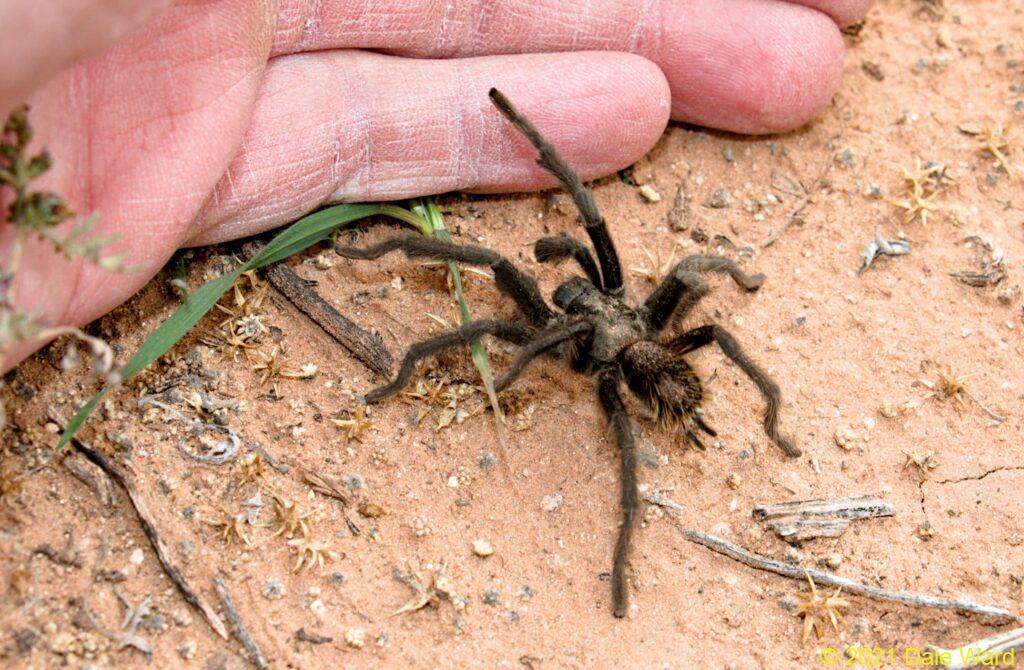 Male Grand Canyon Black Tarantula, with my hand for scale. This is a typical size for males. You can see that these Tarantulas are not very large.
Male Grand Canyon Black Tarantula, with my hand for scale. This is a typical size for males. You can see that these Tarantulas are not very large.
The last time I tried to identify a Tarantula, I had a terrible time of it. Fortunately, Drs. Harrison, Hendrixson and Bond revised the taxonomy and wrote a new key in 2016 - see “Sources” below for a link to their paper.
That key subsumed a number of species into Aphennopelma marxi - the Grand Canyon Black Tarantula. It’s the only species that we have here in Southwestern Colorado.
I know that it doesn’t matter to the Tarantula, but I feel better to know what species I’m looking at.
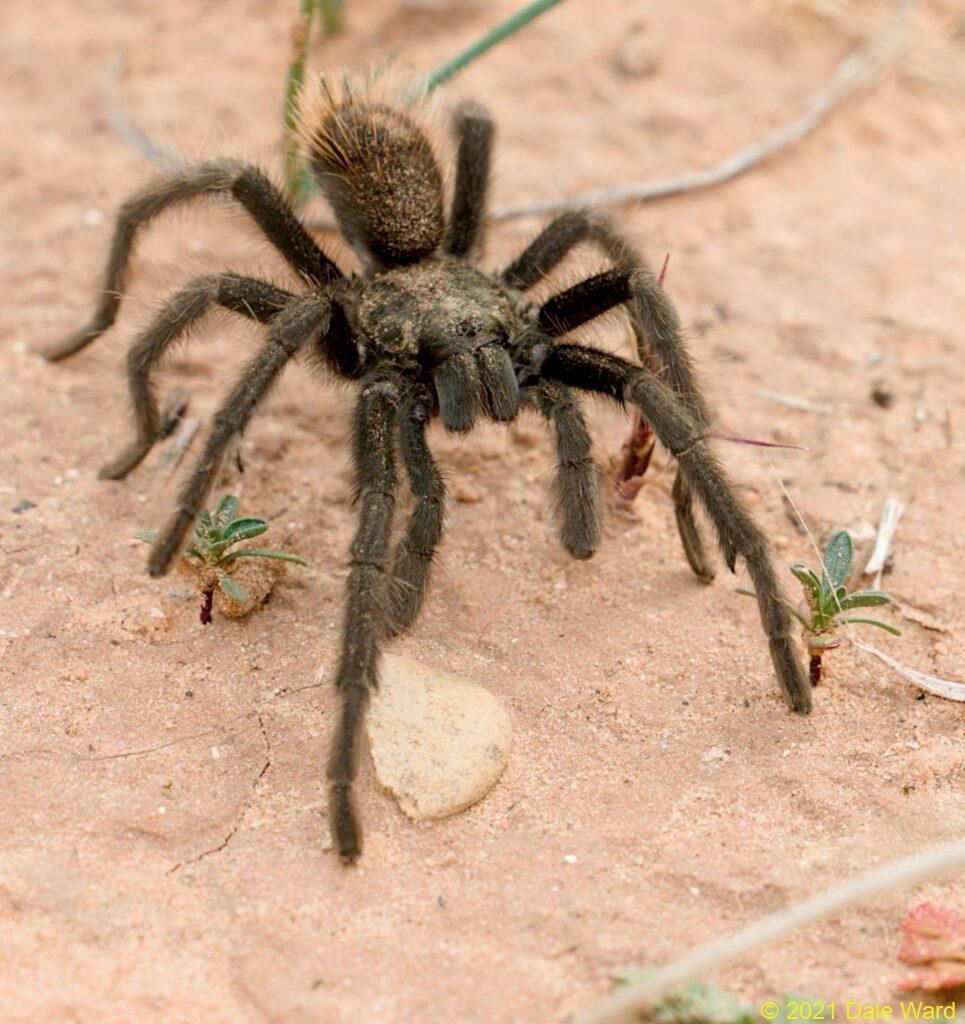 Male Grand Canyon Black Tarantula walking on the desert floor.
Male Grand Canyon Black Tarantula walking on the desert floor.
An interesting thing about Tarantulas - one of their primary defenses against predators is the little black hairs on the spider’s body. The hairs detach easily from the spider, and are small enough that they’ll float in a little cloud for a time after being detached. They’re called “urticating” hairs because they cause an irritation or an itching sensation when they come into contact with sensitive skin.
When something annoys the spider, it’ll turn to face away from the threat, and make flicking motions with its hind legs. With each flick, the spider’s legs rub against the spider’s gaster and dislodge a cloud of the hairs.
Whoever is bothering the spider can get a noseful of these itching hairs. The hairs are sufficiently irritating that they can give humans an itchy rash if the hairs land on sensitive skin, such as the skin of our inner arm. So imagine how annoying it would be for a Mouse or a Coyote to get a snootful of these hairs.
In the photo below, you can see a patch on the Tarantula’s gaster where the black color is missing. That’s a spot where the spider has rubbed off its urticating hairs. I often find spiders with the hairs rubbed off asymmetrically like this. That suggests that the spiders might preferentially “flick” with one of their legs. I wonder if that means that the spiders can be right- or left-handed.
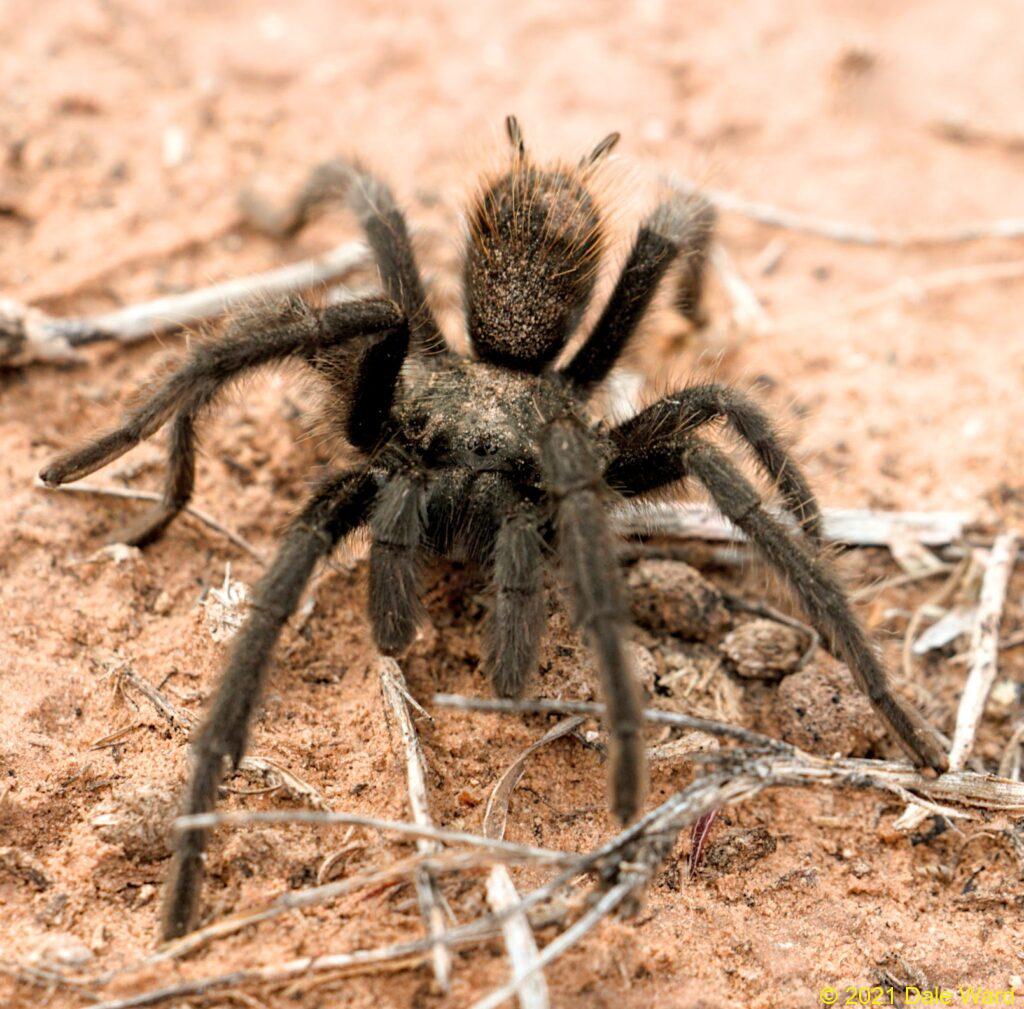 Male Grand Canyon Black Tarantula facing into the camera
Male Grand Canyon Black Tarantula facing into the camera
The hairs will regrow the next time the spider sheds its skin…although mature males won’t live to shed their skins again.
 Male Grand Canyon Black Tarantula walking on the desert floor.
Male Grand Canyon Black Tarantula walking on the desert floor.
There doesn’t seem to be a lot known about the biology of these Tarantulas. Females and immature males mostly stay inside their burrows. After 5-7 years of living mostly in a burrow, the males matures and go forth on a quest for mates.
The males usually die in the same year that they mature. Even if they’re taken into captivity, they usually die a couple of months after their mating march.
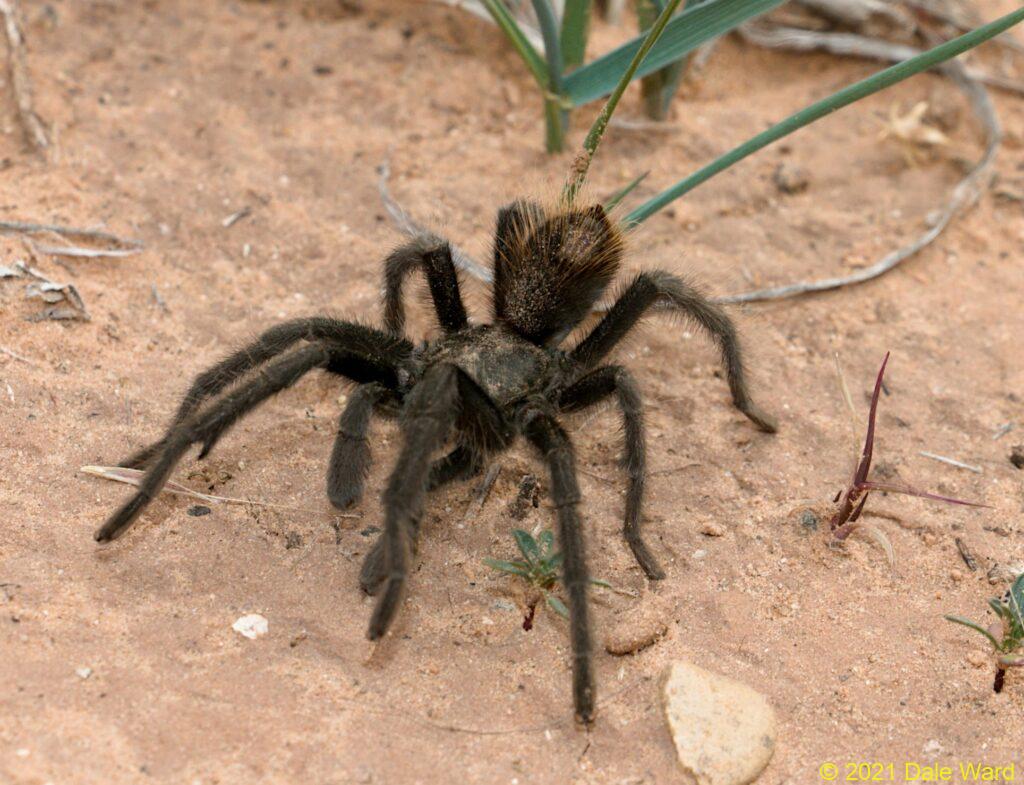 Male Grand Canyon Black Tarantula.
Male Grand Canyon Black Tarantula.
You can tell this spider is a mature male several ways For one thing, it’s got a spindly body - females are usually more robust.
Another thing is that the spider has swollen tips on its pedipalps - the shorter, first pair of legs. The male uses those to like a pair of syringes, to transfer sperm to the female.
Finally, and perhaps most cool - the spider has “mating hooks”. Those are hooks on the spider’s first pair of walking legs. When the male approaches a female to mate, the female rears up in a defensive position. The male will hook the female with those mating hooks, holder her fangs away from him while he mates.
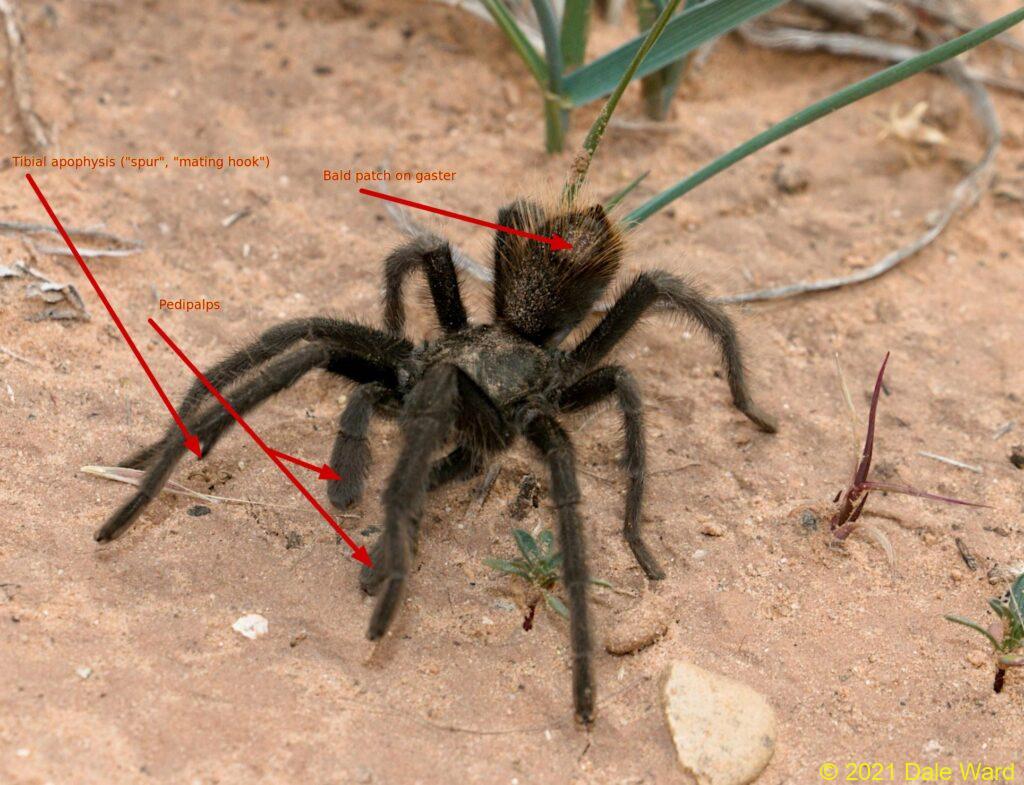 Grand Canyon Black Tarantula with “mating hooks”, pedipalps, and “bald patch” labeled. When another animal bothers Tarantulas, the Tarantula will often make a flicking motion with its hind legs, rubbing against its gaster. That flicking motion dislodges small, irritating hairs.
Grand Canyon Black Tarantula with “mating hooks”, pedipalps, and “bald patch” labeled. When another animal bothers Tarantulas, the Tarantula will often make a flicking motion with its hind legs, rubbing against its gaster. That flicking motion dislodges small, irritating hairs.
I let this spider continue on its way after our photo session. I helped another across the road a few miles down the road, as I was on my way home.
We’ve had nights below freezing lately, so I think the mating season is winding down. I hope that they succeeded in finding females before the hard frosts come.
Sources:
Hamilton CA, Hendrixson BE, Bond JE (2016) Taxonomic revision of the tarantula genus Aphonopelma Pocock, 1901 (Araneae, Mygalomorphae, Theraphosidae) within the United States. ZooKeys 560: 1-340. https://doi.org/10.3897/zookeys.560.6264.
Note that this male “migration” is a well-known event here in the Four Corners area. Here’s a 2019 article from our local paper, the Cortez Journal.